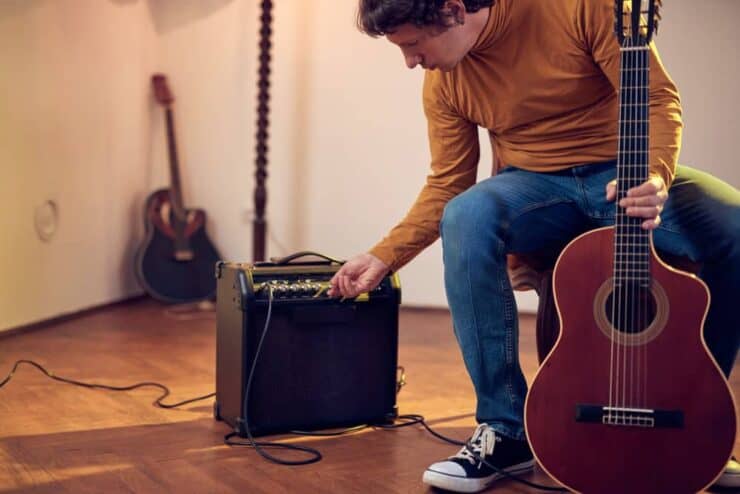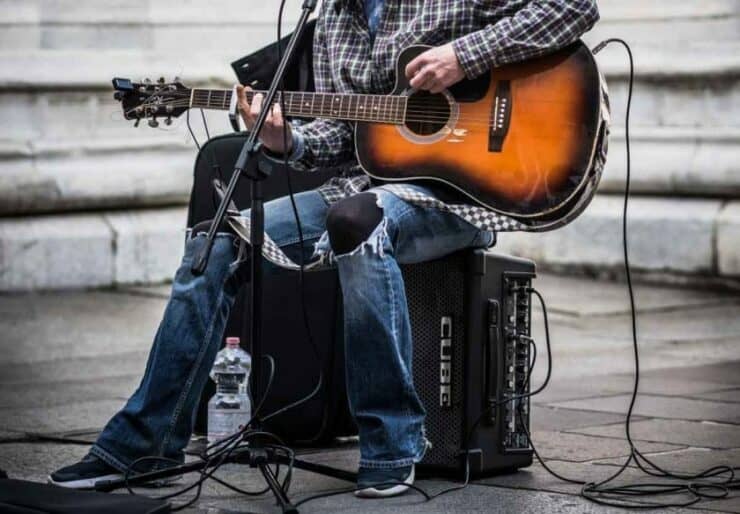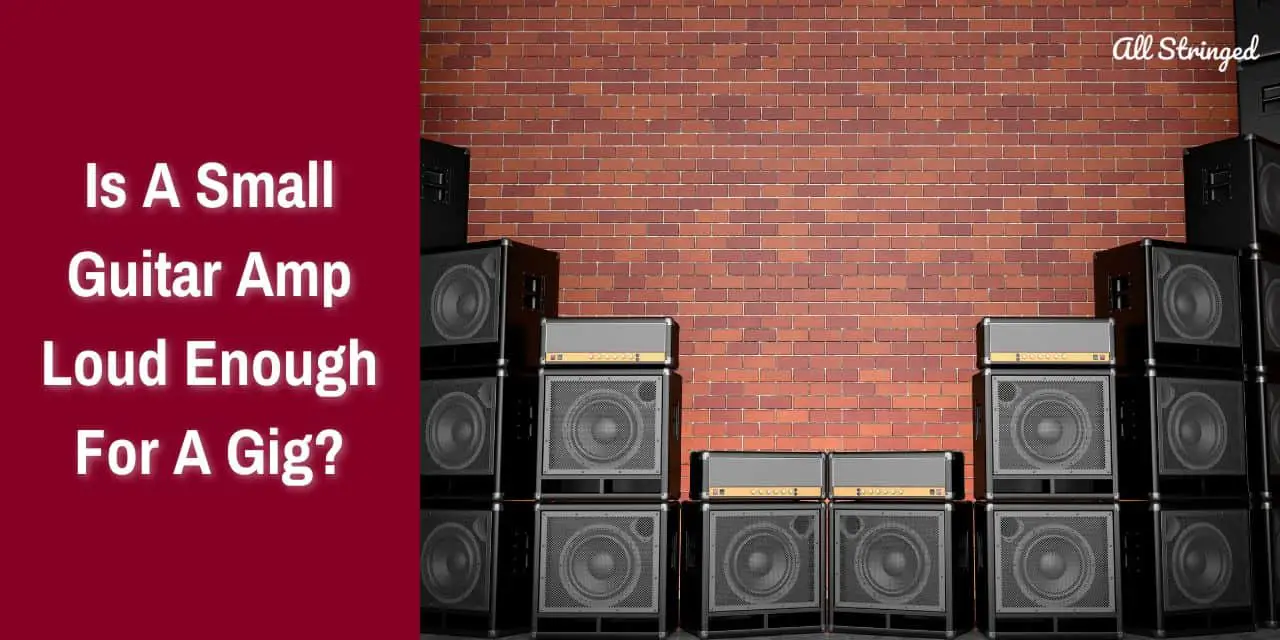Are you a guitar player looking to get the right amp for your next gig? Choosing the right amp can be a daunting task, and it’s important to get it right. With the variety of amps on the market, you may be asking yourself if a small amp is loud enough for a gig. In this article, we’ll discuss the options available and provide some helpful tips on finding the right amp for your needs. By the end, you’ll know if a small guitar amp is loud enough for your next gig. Let’s get started!
Is a small guitar amp loud enough for a gig?
Small guitar amps with 15 to 20W power capacity work well if you have to play gigs in certain situations. Whether they are the perfect option for you will depend on a variety of factors such as what genre of band you are in, how much effort you are willing to put in to help the amp get the job done, and how your group manages sound reinforcement.
A 20W small guitar amp is loud enough compared to sounds in the normal world. However, for a band, it might not be enough in every situation. This will depend on the type of music you and other musicians are going to play.
>>> Click here to read our review about the Top 15 Best Small Guitar Amps <<<
Acoustic drum kits are quite loud, especially when they’re pummeled by a hard-hitting rock or metal drummer. In comparison, a bigger amp could easily end up drowning out a low-wattage guitar amp. It is even more prevalent if your band has another guitarist who loves cranking up a 100W tube amp to 11. Then you will definitely struggle to be heard.
This is why most musicians prefer going for tube amps that are either 40W or above and solid-state amps that are 80W or above. This makes even more sense if you do not want to spend a huge sum but still want something that is powerful enough for performing a gig. It is important that you should understand the difference between small guitar amps and large guitar amps as well as different types of amps when making this decision.
In certain situations, you might be able to use a small guitar amp in a band, especially when you are performing in a smaller venue. There are many variables to consider and the first one will be whether or not you’re able to mic up your guitar amp. Making use of a sound reinforcement system and a microphone will mean that your small amp can be easily head alongside the rest of the group at gigs.
What to consider when choosing a guitar amp for a gig
Selecting the right guitar amp will be important for musicians who are preparing for live performances. There are many factors that come into play when selecting a guitar amp that is suitable enough for gigs. Understanding these factors and their impact on your sound and performance will help you make a better decision when selecting a guitar amp for gigging. Here are some of the factors you need to consider when choosing a guitar amp for a gig –

#1. Power rating
The power rating of a guitar amp determines its volume and headroom capabilities. For gigging purposes, it’ll be important to consider a guitar amp that has sufficient power to cut through the mix and fill the venue.
Low-wattage amps (around 5-20W) from the likes of Marshall and other guitar amp manufacturers can be suitable for small venues and intimate performances. They offer a desirable natural tube breakup at lower volume levels, which allows for more responsive and dynamic playing. Larger venues or louder bands might require higher-wattage amps (30W or above) to make sure there is ample volume and headroom. These guitar amps provide more clean headroom and allow for better control over dynamics.
#2. Speaker size
The speaker size greatly affects the overall tone, projection, and dispersion of the sound produced by the amp. Different speaker sizes can influence the perceived bass response and overall clarity. There are different options available such as 10-inch speakers, 12-inch speakers, and 15-inch speakers.
Small guitar amps having 10-inch speakers are often compact and portable, which makes them suitable for smaller gigs or situations where space is limited. They typically provide a balanced frequency response with a good midrange presence.
Meanwhile, amps having 12-inch speakers are versatile and widely used for gigging. They offer a balanced tonal response, enhanced bass frequencies, and increased projection, which makes them suitable for a wide range of musical genres. Amps having 15-inch speakers excel in delivering deep bass response and powerful low-end thump. They are typically preferred by bassists or guitarists looking for a heavier, bottom-heavy tone.
#3. Tone controls
Effective tone controls on a small guitar amp allow you to easily shape the sound to match your playing style and the venue’s acoustics. Look for guitar amps with responsive and versatile tone controls such as bass, treble, and mid knobs to fine-tune your desired tonal characteristics.
#4. Effects
Built-in effects can enhance your sound and offer convenience during live performances. Some amps come with built-in effects like delay, reverb, modulation, or overdrive/distortion. Consider your playing style and the music genres you perform for determining whether built-in effects are needed or if you prefer using external pedals.
#5. Connectivity
Having flexible connectivity options will help simplify your setup and allow for seamless integration with other equipment. A line out or headphone jack will allow you to connect your guitar amp or headphone jack will allow you to connect your amp to a mixing console, audio interface, or headphones for direct recording or silent practice.
An effects loop will allow you to connect external effects pedals between the preamp and power amp stages of the amp, preserving the amp’s natural tone while applying effects. An auxiliary input will allow you to connect external devices like MP3 players, smartphones, or laptops, allowing you to play along with backing tracks during rehearsals or performances.
Different types of small guitar amps for gigs
When it comes to small guitar amps for gigging, there are different options available, each with its own unique characteristics and advantages. Understanding the differences between different types of guitar amps will help you make the ideal decision based on your tonal preferences, playing style, and gig requirements. Here are the different types of small guitar amps and their suitability for live performances and gigs –

#1. Tube amps
Tube amps or also known as valve amps have long been a staple in the music industry. They are known for their warm, organic, and dynamic tone produced by vacuum tubes. Tube amps offer rich harmonic content, natural compression, and a dynamic response that reacts to your playing style. They offer a classic vintage sound sought after by musicians and guitarists, especially in rock, blues, and jazz genres.
Tube amps are often preferred for their ability to deliver high-quality, loud volumes while maintaining tonal integrity. The output tubes can be overdriven for natural tube saturation and breakup, delivering the iconic “crunch” or smooth overdrive when pushed.
Tube amps need periodic tube replacement and maintenance. Moreover, their delicate nature makes them more susceptible to damage from transportation and rough handling.
#2. Solid-state amps
Solid-state amps make use of transistors and other solid-state components for amplifying the guitar signal. They offer durable, reliable, and cost-effective options for live performers and gigging musicians. These amps are known for their stability and consistency in tonal reproduction. You can enjoy a clean, accurate sound representation, which makes them suited for genres that require precision and clarity, such as pop, funk, or metal.
Solid-state amps are much more affordable than their tube counterparts, which makes them a budget-friendly option for musicians looking for reliability and consistent performance. They’re also lighter and more portable than tube amps, making them quite convenient for musicians and guitarists who frequently travel or perform in different venues.
#3. Digital modeling amps
Digital modeling amps make use of digital signal processing technology for simulating the sound and characteristics of various vintage and modern amplifiers, effects, and speaker cabinets. Digital modeling amps offer an impressive range of tonal options, allowing you to easily emulate different amp models and effects. They offer versatility, making them suited for various genres and playing styles.
Digital modeling amps also come with built-in effects, amp models, and speaker simulations in a compact and portable package. This eliminates the need for carrying multiple pedals or external gear, which makes them convenient for gigging musicians.
These amps also provide a great platform for learning and experimenting with different tones and effects. They come with software interfaces for deep editing and customization, allowing you to dial in your preferred sound.
How to test a small guitar amp for gigs?
Choosing the ideal small guitar amp for gigging will require careful consideration and evaluation. While specifications and features are quite important, nothing compares to the experience of listening to sound samples and testing the guitar amp in person. Here is the right method you should follow for testing your small guitar amp and deciding if it has enough quality, responsiveness, and suitability for your gigging needs.
Listening to sound samples
Sound samples, whether available online or recorded offer a valuable resource for evaluating a guitar amp’s tonal characteristics and versatility. There are different ways to listen to sound samples. For instance, there are several websites and platforms that provide different sound samples of various guitar amps. You should listen to recordings that feature different playing styles, genres, and settings to get a sense of how the guitar amp responds to different musical contexts.
You can also seek out videos or recordings of professional guitarists using the small guitar amp you are considering. Pay close attention to how the amp handles different playing techniques, dynamics, and musical genres relevant to the gigging requirements.
Listen to sound samples through high-quality headphones, studio monitors, or reference speakers to get a more accurate representation of the guitar amp’s tonal characteristics. You must remember that the sound might vary depending on the quality of the recording and playback equipment.
Testing the amp in person
While sound samples do offer a usable starting point, nothing compares to the experience of testing an amp in person. There are several steps to follow when evaluating the small guitar amp in a store or during a personal demonstration. Testing the small guitar amp with your own guitar will be important. This will allow you to assess how your instrument’s pickup, tonewoods, and other factors interact with the amp, giving you a much more accurate representation of the sound you are achieving during live performances.
You can experiment with various playing techniques, such as strumming, fingerpicking, picking, and using different dynamics. Assess how your amp responds to your playing style, whether it is accurately reproducing the nuances of your playing, and how it translates your dynamics into sound.
Explore the range of tones and sounds the small guitar amp can produce. You should experiment with different settings, tweak the tone controls, and switch between clean and distorted channels. Determine whether the guitar amp can deliver the desired tonal palette for your gigging requirements.
Push the small guitar amp to its limits and evaluate how it handles higher volume levels. Make sure that the amp provides sufficient headroom without distorting or losing clarity. This is especially important for gigs where you might be needed to play at higher volumes to cut through the mix.
If the amp offers connectivity options like an effects loop, headphone jack, or line out, you should test these features with your own equipment to ensure functionality and compatibility.
Benefits of using a small guitar amp for gigging
When it comes to gigging as a guitarist, having the right equipment will be important. A small guitar amp offers numerous advantages that make it an attractive option for live performances. Here are some of the benefits of using a small guitar amp –
#1. Portability
One of the key advantages of a small guitar amp is its portability. Gigging typically involves moving equipment from one venue to the other and a compact guitar amp will make this task much more manageable.
Small guitar amps are typically lightweight, which makes them easy to carry, transport and fit into small vehicles. They are perfect for musicians who frequently perform in different locations or have to navigate stairs and tight spaces. Small guitar amps take up less space on stage, which allows for better stage management and placement. They also reduce the strain on your back and arms when setting up and tearing down for gigs.
Small guitar amps aren’t limited to gigging. They are also amazing for practice sessions at home or in rehearsal spaces. Their compact size will allow you to practice and experiment with different tones without disturbing others or sacrificing sound quality.
#2. Tone
Despite the smaller size, modern small guitar amps offer impressive tonal capabilities. Many small guitar amps feature multiple channels, gain controls, and onboard effects, allowing you to achieve a wide range of tones suitable for various musical genres. From clean and chimey to warm and crunchy tunes, these amps are able to cover a wide spectrum of sounds, which will give you the flexibility to adapt to different sounds and playing styles during live performances.
They’re able to deliver sparkling cleans, gritty overdrive, and high-gain distortion, giving you the flexibility to easily adapt to different songs and playing styles during gigs.
Advancements in amp technology have made it possible for small guitar amps to easily deliver exceptional sound quality. With improved circuitry and speaker design, these guitar amps are able to produce rich, detailed tones that rival larger and more expensive counterparts.
Another area where small guitar amps benefit is effects integration. Some small guitar amps come with a wide range of built-in effects, such as reverb, delay, or modulation. This will allow you to add depth and ambiance to your sound without having to use external pedals. This will simplify your setup and reduce the number of individual components that you need to carry and manage.
Many small guitar amps also feature recording outputs or direct outputs. This will allow you to easily connect the small guitar amp directly to a mixing console, audio interface, or PA system. It helps ensure that the sound can be captured more accurately and be easily integrated into a live mix or recording setup.
In larger venues, small guitar amps can be mic’d up easily and connected to the PA systems. This ensures that your tone is reaching the audience without compromising on sound quality. This will allow you to maintain control over your tone while benefiting from the additional amplification provided by the venue’s sound system.

#3. Cost-effectiveness
Small guitar amps often come with a much more affordable price tag compared to larger and more powerful models. These amps also offer an attractive cost-to-performance ratio, which makes them an extremely budget-friendly option for gigging musicians.
If you are on a tight budget or simply starting out as a gigging musician, a small amp will offer a cost-effective solution. You’ll be able to invest in a quality amp without breaking the amp. This will allow you to allocate your budget toward other essential gear.
Small guitar amps tend to be much more affordable than larger, high-powered models. These devices provide a cost-effective solution for musicians who might have budget constraints or are simply starting their gigging journey.
Small guitar amps are perfectly suited for intimate venues, cafés, and smaller stages. As they do not require excessive volume, they’ll eliminate the need for higher-wattage amps that can be more expensive. Despite the lower price point, small guitar amps can deliver impressive sound quality and performance. Manufacturers are continuously improving the features and technology in smaller models, offering excellent value for money.
Despite the lower price point, small guitar amps are able to deliver impressive sound quality and maintenance. Manufacturers are continuously improving the features and technology in smaller models, ensuring that you get the most bang for your buck.
Small guitar amps come with fewer components and simpler designs. This results in lower maintenance and repair costs over time. This will allow you to easily focus your financial resources on other aspects of your musical endeavors.
FAQs
How loud can a small guitar amp be?
Small guitar amps are typically less powerful than larger amps, so they may not be loud enough for a gig. However, the exact volume level of a small amp will depend on the wattage, speaker size, and sound quality of the amp. Generally speaking, small amps are best used for practicing and rehearsing, rather than for performing at large gigs.
What are the benefits of using a small amp for a gig?
Small amps are typically more affordable and portable than larger amps, making them a great choice for gigs where space and budget are limited. They are also easier to transport and set up than larger amps, making them convenient for gigging musicians.
What are the drawbacks of using a small amp for a gig?
Small amps usually don’t produce as much volume or projection as larger amps, so they may not be suitable for larger venues. Additionally, they may not have enough power or features to cover all of the sounds needed for a gig. It’s important to consider the size of the venue, the type of music you will be performing, and your budget when deciding whether a small amp is suitable for a gig.



